Types And Applications Of All-Kinds Of Ceramic Materials
Time of issue: 2024-04-18 10:09:13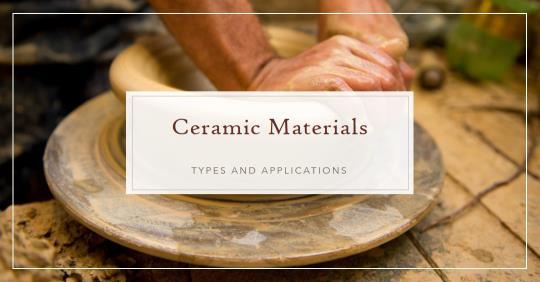
Ceramic materials are used extensively in current engineering and design. They come in a wide range of types, each with its own set of qualities and applications. These materials are employed in a variety of industries, including sophisticated ceramics for aerospace and porcelain. The ceramic materials industry is currently valued at 267.7 billion dollars.
Global Reach Ceramic specializes in a wide range of ceramic materials, which serve as the foundation for modern engineering and design.
This blog digs into the various forms of ceramics, highlighting different materials and their applications. Learning about ceramics can demonstrate how vital they are in a variety of businesses, whether you are interested in their aesthetic appeal or their ability to withstand high temperatures.
Come explore with us how Global Reach Ceramic are affecting modern technology.
Let Defend Ceramics Materials
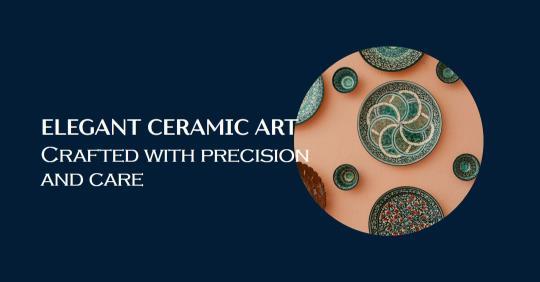
Ceramic materials are inorganic, non-metallic materials that are typically made by shaping and then firing a non-metal substance at high temperatures.Because they are made of natural materials like clay and silica, ceramics have a well-deserved reputation for being very strong and immune to heat. Because they don't break easily when heated and last a long time, they can be used in many different ways, from traditional pottery and tiles to cutting edge technology in biomedicine and space travel. You can divide ceramics into two main groups: "traditional," which are made from natural materials, and "advanced," which are made from man-made materials like silicon carbide and alumina that are designed to meet the needs of certain industries.
What Are Ceramics Made Of?

Ceramics can be made from a variety of materials, the most common of which are inorganic and nonmetallic compounds heated until solid. Most ceramics are made of the following base materials:
| Material | Description |
| Clay | The most traditional ceramic material, clay is composed of minerals with fine particles, providing plasticity when wet and strength when fired. Clays such as kaolin are particularly important for making porcelain. |
| Silica (SiO2) | Often used in combination with clay, silica adds strength and vitrification (the transformation of a substance into glass) to ceramic products. It is a primary component in glass ceramics. |
| Alumina (Al2O3) | A key ingredient in advanced ceramics, alumina is known for its high melting point, hardness, and resistance to wear. It's used in applications requiring high thermal or electrical insulation. |
| Other Metal Oxides | These include zirconia (Zirconium Dioxide) and titania (Titanium Dioxide), which are used to enhance specific properties like toughness and durability. |
| Cements and Gypsum | Other Metal Oxides:Cements and Gypsum: These materials, along with lime, are used in ceramic products that need to set or harden, such as in construction materials like bricks and tiles. |
| Additives | Various fluxes (substances added to lower the melting point), colorants, and other additives are used to modify the properties and appearance of the final ceramic product.
|
Types Of Ceramics And It’s Materials
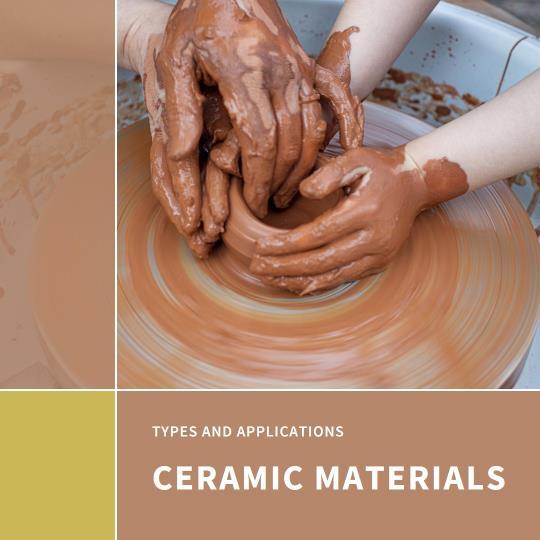
In the world two types of ceramics: Classical ceramics and advanced ceramics. From everyday goods to highly sophisticated technical applications, each category has a number of types that serve different objectives.
The table below provides a brief summary types of ceramics, explaining their most notable qualities and most common applications:
| Type of Ceramic | Material Composition | Characteristics and Properties | Common Uses |
| Porcelain | Kaolin clay | Hard, durable, vitrified, non-porous | Fine dinnerware, bathroom fixtures |
| Stoneware | Clay, may include feldspar, quartz | Waterproof, sturdy, opaque finish | Dinnerware, bakeware |
| Earthenware | Clay | Porous, less robust than porcelain or stoneware, often glazed | Decorative items, plant pots, rustic kitchenware |
| Silicon Carbide | Silicon and carbon | High thermal conductivity, wear resistance | Abrasive environments, braking systems, electronics |
| Tungsten Carbide | Tungsten carbide particles, metal binder | Extremely hard, wear-resistant | Cutting tools, industrial machinery |
| Aluminum Oxide | Aluminum oxide | High thermal and electrical insulation | Substrates and insulators in electronics |
| Zirconia | Zirconium oxide | Toughness, resistance to crack propagation | Dental implants, cutting tools |
| Glass Ceramics | Glass plus crystalline phases | High strength, thermal stability, impact resistance | Cooktop panels, aerospace components |
Classical Ceramics
Clay, quartz, and feldspar are some of the natural ingredients used to make traditional ceramics. Molding these materials while they are wet and then heating them to harden is a common practice. Classical pottery comprise:
Porcelain
Strong, long-lasting, and aesthetically pleasing, porcelain is a popular material for both functional and ornamental uses. Kaolin clay, which is burnt at high temperatures to become vitrified and non-porous, is the material used to make it. The exceptional dielectric qualities of porcelain make it a popular material for a wide variety of electrical insulators, as well as for usage in exquisite dinnerware and bathroom fixtures.
Stoneware
One such long-lasting ceramic that uses clay and high temperatures for firing is the stoneware. Dinnerware, bakeware, and other practical products can be made from it because of its vitrification process, which renders it impermeable and strong. Stoneware, in contrast to porcelain, is less fragile and has a denser, opaque surface.
Earthenware
One of the most prevalent and ancient types of pottery is earthenware. Porous and not as strong as porcelain or stoneware, this kind of ceramic is fired at lower temperatures. Its water resistance and visual appeal are enhanced by glazing. Pottery, planters, and rustic cookware are some of the many uses for earthenware.
Advanced Ceramics
Synthetic materials engineered to possess targeted characteristics for use in demanding high-performance contexts make up advanced ceramics. To get properties like high strength, wear resistance, and thermal stability, they are usually manufactured from pure chemical compounds and treated in controlled environments. Here are some examples of advanced ceramics:
Silicon Carbide
One of silicon carbide's (SiC) most notable properties is its resilience to wear and its strong heat conductivity. It finds usage in semiconductor devices, high-performance braking systems, and abrasive settings, among other places where long-term durability is essential.
Tungsten Carbide
The ceramic is composed of tungsten carbide particles that are fused with a metal, typically nickel or cobalt. Ideal for cutting tools and abrasive water jet nozzles, it is exceedingly hard and wear-resistant. Another option for making tungsten carbide that finds application in industrial machines is the high-temperature pressing technique.
Aluminum Oxide (Alumina)
When excellent electrical and thermal insulation is required, alumina is the material of choice. Because of its consistency and insulating properties, it is used extensively in the electronics sector to make substrates and insulators.
Zirconia
Dental implants and cutting tools are only two examples of the many uses for zirconia's renown for resilience in the face of adversity. For even more strength and resistance against crack propagation, it can be transformed to undergo toughening.
Glass Ceramics
Glass ceramics are composite materials that exhibit both glassy and crystalline phases. Their exceptional strength, thermal stability, and impact resistance are a result of their engineered integration of the finest qualities of ceramics and glass. Panels for stovetops, telescope mirrors, and even some parts for airplanes are common uses.
Examples of Ceramic Materials
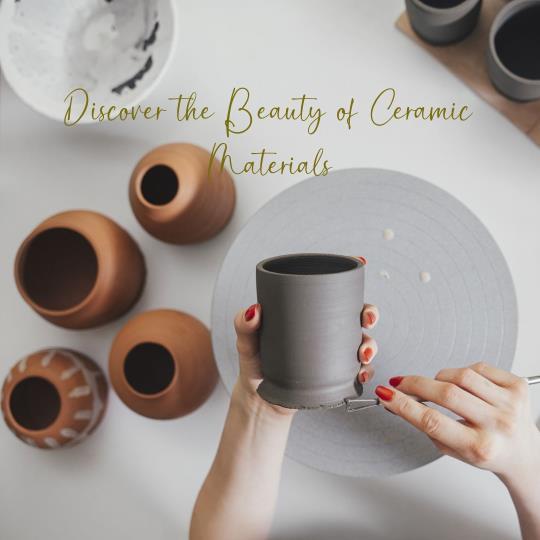
Ceramic materials are incredibly diverse and are used across various industries due to their unique properties such as hardness, heat resistance, and electrical insulation.
Here are some key examples:
- Alumina (Aluminum Oxide, Al2O3): Known for its hardness and electrical insulation properties, alumina is widely used in electrical insulators and in cutting tools.
- Zirconia (Zirconium Oxide, ZrO2): Highly valued for its toughness and resistance to cracking, zirconia is commonly found in dental implants and cutting tools.
- Silicon Carbide (SiC): With excellent thermal conductivity and wear resistance, silicon carbide is used in high-stress applications such as abrasive environments and car brakes.
- Porcelain: Often used in tableware and sanitary ware, porcelain is prized for its glossy finish and excellent resistance to chemical and thermal shock.
- Titanium Carbide: Known for its stiffness and resistance to wear, titanium carbide is used in machine tools and wear-resistant coatings.
- Glass Ceramics: These materials are used in cooktops and other household appliances due to their thermal shock resistance and toughness.
- Fire Bricks: Made from refractory ceramic materials, fire bricks are used to line furnaces and kilns due to their ability to withstand very high temperatures.
- Bone China: A type of porcelain that includes bone ash in its composition, making it strong and chip-resistant, commonly used in high-quality dinnerware.
Applications of Ceramics Materials?
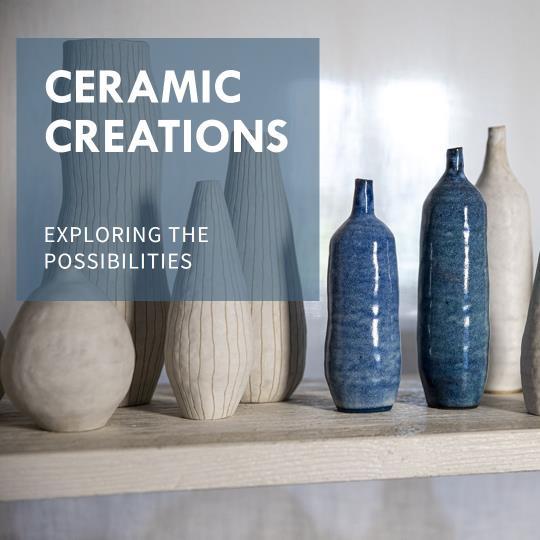
Ceramics are utilized in a diverse range of applications across multiple industries due to their unique properties such as high temperature resistance, hardness, and electrical insulation capabilities.
Industrial and Technical Applications
Ceramics materials play a critical role in various industrial applications. Crucibles, kiln linings, and fire radiants are refractories made from these materials, and they are vital in procedures that involve high temperatures. When it comes to cutting and grinding tools and abrasive components, advanced ceramics like silicon carbide and tungsten carbide are the go-to materials. According to various sources, including Manufacturing on Demand, Science Notes and Projects, Encyclopedia Britannica, and AdvancedCeramicMaterials, ceramics are used in sensors that control and monitor the exhaust gases in automobiles in order to optimize fuel-to-air ratios. This, in turn, leads to better fuel efficiency in the automotive industry.
Electronics and Electrical Devices
Because of their insulating and semiconducting qualities, ceramics are extensively used in the electronics sector. Ceramics are the building blocks of many electrical components, including insulators, capacitors, and, at a more sophisticated level, semiconductors and superconducting materials. According to Manufacturing on Demand and the American Ceramic Society, they play an essential role in the assembly of various consumer electronics, including computers, smartphones, and other similar devices.
Aerospace and Defense
Ceramics are highly esteemed in the aerospace and defense industries for their lightweight and robust qualities, which help improve fuel efficiency and payload capacity. According to the Encyclopaedia Britannica, they find usage in turbine blades, space shuttle tiles, and other structural components of modern aeronautical designs.(Encyclopedia Britannica).
Biomedical Applications
Bioceramics, which include advanced ceramics like zirconia and alumina, are very durable and biocompatible, making them ideal for use as medical implants and prostheses. The hardness and wear resistance of these materials are crucial in joint replacements and dental implants (Science Notes and Projects) (Science Learning Hub).
Household and Everyday Uses
In the domestic sphere, ceramics are found in objects such as cookware, cutlery, and even as decorative pieces. Ceramics are great for cooktops, bakeware, and other culinary tools because they are both aesthetically pleasing and resistant to high temperatures (Manufacturing on Demand) (Matmatch).
Energy Sector
The energy sector, and especially renewable energy technologies, rely on ceramics. For energy conversion devices like solid oxide fuel cells, their resistance to high temperatures and corrosive conditions is essential (MDPI).
These examples illustrate just how integral ceramics are to modern technology and everyday items, showcasing their versatility and importance across different sectors.
Future of Ceramic Materials
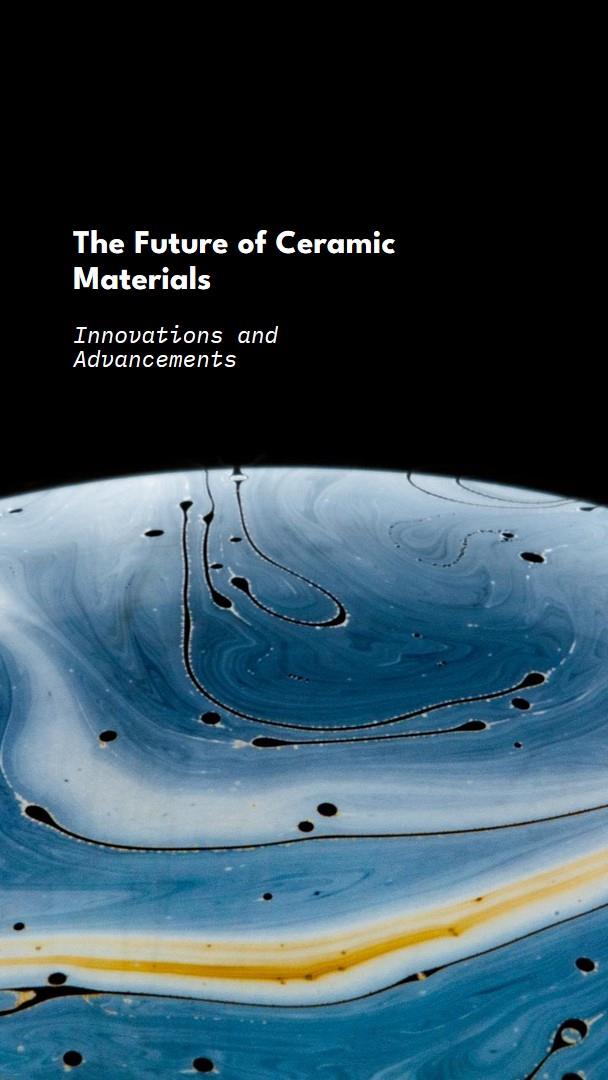
Emerging Technologies in Ceramic Manufacturing
Technological innovations such as 3D printing are altering the ceramic sector and making it easier to create unique, detailed designs. Furthermore, advances in the field of ultra-high temperature ceramics (UHTCs) make these materials more resistant to extreme heat, making them ideal for aerospace applications.
Potential New Materials and Applications
Novel ceramics are being developed for optical and photonic applications requiring long-term stability and optical transparency. The creation of self-healing ceramics is another example of a revolutionary material. This is extremely useful in difficult or otherwise inaccessible environments. Ceramics have the potential to have a substantial impact on future energy technologies by enhancing fuel cell and battery performance in severe settings.
Because of these advancements, ceramics are becoming increasingly significant in a variety of industries, and they may soon be indispensable to both everyday items and cutting-edge technology.
Final Remarks:
Emerging technology and new applications show enormous promise for the future of ceramic materials, with the potential to change industries and improve everyday things.
At Global Reach Ceramic, we are always exploring new possibilities, such as the use of 3D printing and ultra-high temperature ceramics in aerospace. We are happy to be on the cutting edge of these breakthroughs. We will continue to provide cutting-edge solutions to meet our clients' evolving needs since we are committed to innovation.
Thanks for reading our articles.
RECENT POSTS
- The Benefits of Wholesale High-Quality Ceramic Products for Retailers
2025-12-17
- Can You Make an Ashtray with Air Dry Clay? Pros, Cons, and Safer Alternatives
2025-12-17
- The Impact of Ceramic Materials in Energy-Efficient Buildings: Benefits and Applications
2025-12-04
- Top 7 Ceramic Cookware Health Benefits: Why It’s a Safer Choice for Your Kitchen
2025-12-04
- How to Clean Ceramic Planters and Improve Their Lifespan?
2025-11-17
- 15 Best Ceramic Holiday Gift Ideas for 2025: Thoughtful, Elegant & Heartfelt
2025-11-17
- Stoneware vs Porcelain vs Earthenware: Quick Decision Guide
2025-10-09
- Are Ceramic Glazes Food Safe? The Truth Behind the Shine
2025-10-09










